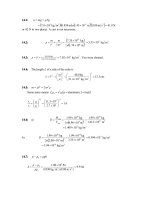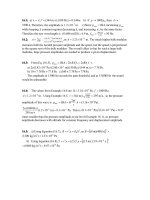- Trang chủ >>
- Khoa Học Tự Nhiên >>
- Vật lý
Tài liệu Physics exercises_solution: Chapter 19 pptx
Bạn đang xem bản rút gọn của tài liệu. Xem và tải ngay bản đầy đủ của tài liệu tại đây (263.51 KB, 28 trang )
19.1: a)
b)
.J1033.1)C80)(KmolJ3145.8)(mol00.2(
3
TnRVp
19.2: a)
b) If the pressure is reduced to 40.0% of its original value, the final volume is
)25(
of its original value. From Eq. (19.4),
J.1015.9
2
5
ln )K)(400.15KmolJ3145.8)(3(ln
3
1
2
V
V
nRTW
19.3:
nRTpV
T constant, so when p increases, V decrease
19.4: At constant pressure,
so,TnRVpW
C.62.1C35.1C0.27so,Tand
K1.35
K)molJ(8.3145mol)(6
J1075.1
2CK
3
TT
nR
W
T
19.5: a)
b) At constant volume,
0.soand0 WdV
19.6:
b)
J.1050.4)m0900.0m(0.0600Pa)10(1.50
3335
Vp
19.7: a)
b) In the first process,
0
1
VpW
. In the second process,
J.1000.4)m0.080(Pa)10005(
435
2
.VpW
19.8: a)
.0 and)(,0),(
41212243212113
WVVpWWVVpW
The total work done
by the system is
),)((
122141243213
VVppWWW W
which is the area in the p- V
plane enclosed by the loop. b) For the process in reverse, the pressures are the same, but
the volume changes are all the negatives of those found in part (a), so the total work is
negative of the work found in part (a).
19.9:
J73J, 254 WQ
(work is done on the system), and so
J. 327 WQU
19.10: a)
J.1078.3)mPa)(0.2101080.1(
425
Vp
b)
J.107.72J103.78J1015.1
445
WQU
c) The relations
WQUVpW and
hold for any system.
19.11: The type of process is not specified. We can use
WQU
because this applies
to all processes.
Q
is positive since heat goes into the gas;
J1200Q
W
positive since gas expands;
J2100W
J900J2100-J1200 U
We can also use
TRnU
2
3
since this is true for any process for an ideal gas.
C4.14
K)molJ5mol)(8.3143(5.00
J)900(2
3
2
nR
U
T
C113C14.4C127
12
TTT
19.12: At constant volume, the work done by the system is zero, so
.QWQU
Because heat flows into the system,
Q
is positive, so the internal
energy of the system increases.
19.13: a)
J1015.1)mPa)(-0.501030.2(
535
Vp
.
(b
J1055.2J)1015.1(J1040.1
555
WUQ
(heat flows out of the gas).
c) No; the first law of thermodynamics is valid for any system.
19.14: a) The greatest work is done along the path that bounds the largest area above the
V-axis in the p- V plane (see Fig. (19.8)), which is path 1. The least work is done along
path 3.
0 Wb)
in all three cases;
0so, QWUQ
for all three, with the greatest
Q for the greatest work, that along path 1. When
,0Q
heat is absorbed.
19.15: a) The energy is
kcal,139g)kcalg)(9.0(7.0g)kcalg)(4.00.17()gkcal0.4)(g0.2(
and the time required is
mKv 2b)min.16.4h0.273h)kcal(510kcal)139(
h.km501sm139kg)60(cal)J(4.186cal)10139(2
3
19.16: a) The container is said to be well-insulated, so there is no heat transfer. b) Stirring
requires work. The stirring needs to be irregular so that the stirring mechanism moves
against the water, not with the water. c) The work mentioned in part (b) is work done on
the system, so
,0W
and since no heat has been transferred,
.0 WU
19.17: The work done is positive from a to b and negative from b to a; the net work is the
area enclosed and is positive around the clockwise path. For the closed path
,0U
so
A.0 WQ
positive value for Q means heat is absorbed.
b)
J.7200soand0(a),part fromandJ,7200 WQQQ
c) For the counterclockwise path, Q = W < 0. W=
J7200soJ,7200 Q
and heat
is liberated, with |Q|=7200 J.
19.18: a), b) The clockwise loop (I) encloses a larger area in the p-V plane than the
counterclockwise loop (II). Clockwise loops represent positive work and
counterclockwise loops negative work, so
.0and0
III
WW
Over one complete cycle,
the net work
,0
III
WW
and the net work done by the system is positive. c) For the
complete cycle,
.so and0 QWU
From part (a), W > 0 so Q > 0, and heat flows
into the system. d) Consider each loop as beginning and ending at the intersection point
of the loops. Around each loop,
.0and0 then,;so,0
IIIIII
WQWQWQU
Heat flows into the system for loop I and out of the system for loop II.
19.19: a) Yes; heat has been transferred form the gasses to the water (and very likely the
can), as indicated by the temperature rise of the water. For the system of the gasses,
0Q
.
b) The can is given as being constant-volume, so the gasses do no work. Neglecting the
thermal expansion of the water, no work is done. c)
.0 QWQU
19.20: a)
J.1067.1)m1000.1mPa)(0.82410026.2(
53335
Vp
J.10032J1067.1)kgJ10kg)(2.2000.1(
b)
656
v
.
WmLWQU
19.21: a) Using Equation (19.12),
orK,9.167d
K)molJmol)(20.76(0.185
J645
d
V
nC
Q
T
T = 948 K.
b) Using Equation (19.14),
K.900or K,9.119d
.K)molJmol)(29.07(0.185
J645d
TT
p
nC
Q
19.22: a)
J.4.99)CK)(40.0molJmol)(12.470100.0( TnC
V
19.23:
C30.0mol.00.5 Tn
a) For constant p,
J3120)CK)(30.0molJmol)(20.7800.5( TnCQ
p
0Q
so heat goes into gas.
b) For constant V,
J1870)CK)(30.0molJmol)(12.4700.5( TnCQ
v
Q > 0 so heat goes into gas.
c) For constant p,
J5540)CK)(30.0molJmol)(36.9400.5( TnCQ
p
Q > 0 so heat goes into gas.
19.24: For an ideal gas,
,TCU
V
and at constant pressure,
RCTnRVp
V
2
3
Using.
for a monatomic gas,
J.360)m1000.2m10Pa)(8.001000.4(
2
3
2
3
2
3
33334
VpTRnU
19.25: For constant
TnCQp
p
,
Since the gas is ideal,
nRTpV
and for constant
., TnRVpp
Vp
R
C
nR
Vp
nCQ
p
p
Since the gas expands,
0V
and therefore
0 .0 QQ
means heat goes into
gas.
19.26: For an ideal gas,
,TCU
V
and at constant pressure,
.TnRVpW
Using
RC
V
2
3
for a monatomic gas,
.)(
2
3
2
3
2
3
WVpTRnU
Then
.so,
5
2
2
5
QWWWUQ
19.27: a) For an isothermal process,
4)1K)ln(K)(350.15molJ5mol)(8.314150.0()(ln
12
VVnRTW
J.605
b) For an isothermal process for an ideal gas,
.0and0 UT
c) For a process
with
,0U J605 WQ
; 605 J are liberated.
19.28: For an isothermal process,
J.335so,0 QWU
19.29: For an ideal gas
,1
VVp
CRCCγ
and so
)1(
V
RC
KmolJ5.65)127.0(K)molJ3145.8(
and
K.molJ8.73 RCC
Vp
19.30: a)
b)
)(
1212
TTnRpVpV
J.208K)K)(100.0molJ5mol)(8.314250.0(
c) The work is done on the piston.
d) Since Eq. (19.13) holds for any process,
J.712K)K)(100.0molJmol)(28.46250.0( TnCU
V
e) Either
J10924givesor
3
QWUQTnCQ
P
to three significant
figures.
f) The lower pressure would mean a correspondingly larger volume, and the net
result would be that the work done would be the same as that found in part (b).
19.31:
,11a) γR C
p
and so
J.553
220.111
C0.5KmolJ3145.8mol40.2
TnCQ
p
J.454220.1J553b) γTnCTnC
PV
(An extra figure was kept for
these calculations.)
19.32: a) See also Exercise 19.36;
Pa.1076.4
m0400.0
m0800.0
Pa1050.1
5
3
3
5
2
1
12
3
5
γ
V
V
pp
b) This result may be substituted into Eq. (19.26), or, substituting the above form
for
2
p
,
J.1060.1
0400.0
0800.0
1m0800.0Pa1050.1
2
3
1
1
1
435
1
2
1
11
3
2
γ
V
V
Vp
γ
W
c) From Eq. (19.22),
,59.10400.00800.0
321
1212
VVTT
and since
the final temperature is higher than the initial temperature, the gas is heated (see the note
in Section 19.8 regarding “heating” and “cooling.”)
19.33: a)
)19.6Examplein as,400.1Use(b) γ
From Eq. (19.22),
C495K7681.11K15.293
400.01
2112
VVTT
and from Eq. (19.24),
atm.1.291.11atm00.1
400.1
2112
VVpp
19.34:
0gasdiatomicidealfor 4.1 WUQγ
for adiabatic process
γ
ii
γ
VPPV
PdVWU
const
J. 105.1atmL50
L)(30atm)2.1(
VPdVU
3
4.11
1.4-1
L)30(
1.4-1
L)10(
1.4
10L1
L30
1
1
V
ii
V
VP
10L
L30
i
i
The internal energy increases because work is done on the gas
0).( U
The temperature increases because the internal energy has increased.
19.35: For an ideal gas
TnCU
V
.
.ofsign theassame theisofsign The TU
decreases.gas theof
energy thenegative;issonegativeis.sopositiveis1and
)(and
so,and
1212
1
1212
1
22
1
11
1
22
1
11
UTTTpp
ppTTpTpT
pnRTVVTVT
19.36: Equations (19.22) and (19.24) may be re-expressed as
.,
2
1
1
2
1
2
1
1
2
γγ
V
V
p
p
V
V
T
T
K.298)32(K)350(atm,27.2)32(atm)00.4(,b)
K.267)32K)(350(atm,04.2)32atm)(00.4(,)
5
2
5
7
3
2
3
5
22
5
7
22
3
5
Tpγ
Tpγa
19.37: a)
b) From Eq. (19.25),
)C(40.0K)molJ(12.47mol)(0.450 TnCW
V
J.224 WWQU
flow.heat nois thereand0process,adiabatican For J.224 Q









